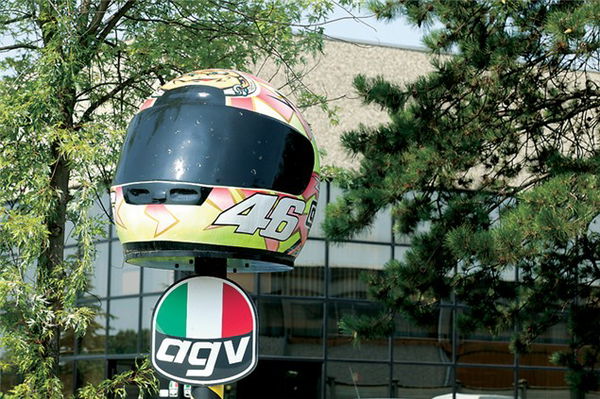Crown Jewels - AGV Helmets
So just how do Italian helmet manufacturers AGV protect the most precious head in motorcycle racing? Bertie headed to Italy to find out making a helmet for Valentino Rossi must be akin to trying to make a crown fit for a king


He's going to have to like it, right? What happens if he doesn't like the design? What if it doesn't fit him? And the most important question, what if he nicks off to the opposition because you're not paying him enough?
That's the question I wanted to ask as soon as I got through the door at AGV: Just how much does Valentino Rossi get paid to wear one? You wanna know, I wanna know, we all wanna know. But, I've been around. In journalistic circles it's called the bucket question. It's the one you ask right at the end just as you realise you're at the end of an interview and are obviously running out of your hosts' hospitality.
So, as I passed the giant AGV Rossi replica outside the factory at Spinetta Marengo, I kept this question under my hat. So to speak.
AGV currently have four factories, one in the Czech Republic, one in Malaysia, one in Indonesia and the one in Italy. They've been around for years. They first started making crash helmets back in 1947. Since then they've supported numerous World Champions (they've helped win 142 so far) and race winners. Barry Sheene, Kenny Roberts, Angel Nieto, Giacomo Agostini, Garry McCoy, Manuel Poggiali and some old Scots fart called Niall Mackenzie have all worn AGVs when at the height of their powers.
But then back in 1995 AGV began sponsoring a young 16-year-old kid called Valentino Rossi. At the time he was doing European championships for Aprilia and this lanky son of 350 ace Graziano would go on to great things. A year later - in a team bankrolled by AGV - he won his first 125 GP race. The rest was history and a partnership was formed.
Rossi has been happy to wear AGV's best lid, but for 2003 they wanted to make one that was even better than the old Evo and XR2 models that he'd been using. Jonny Towers has been flogging AGV lids for the last 18 years. He is one of the main men from UK AGV importer Moto Direct who have been selling us the Italian skid lids for the last quarter of a century in this country. He takes up the story.
"The UK is the biggest profit making market for AGV's glass fibre lids, so we have quite a bit of sway as to what AGV builds. In 2001 AGV formed a World Design Committee, and the first thing I wanted to see was a real top of the range lid that could take on the best lids that Arai and Shoei make. That became the Ti-Tech, which Valentino uses today."
But first the Committee had to arrive at a design they liked. They wanted a lid that had an integral set of air ducts in the actual shell of the helmet rather than the traditional set-up of simple holes drilled into the shell over which sit plastic ducts to move the air between them.
By April/May of 2002 the first computer designs of the new lid, as well as a wooden mock-up, were seen by the Committee's various members. "The first design wasn't so good," says Jonny. "It was too smooth, too much like a Shoei and simply not aggressive enough."
By November 2002 things had moved on to the final design. A couple of tweaks had been made, such as a deeper chin bar and attractive titanium end pieces for the vents. The lid was starting to look much more aggressive.
A year in the life of Rossi's helmet
Valentino loves wearing special lids for special occasions. Two which have seen the light of day in 2003 include these. Vale's 'Peace' lid was the Italian's protest against the imminent opening of hostilities against Iraq. The number 7 was a tribute to the recently deceased Barry Sheene. Meanwhile the Italian national football team lid was inspired by Valentino's namesake Paolo Rossi's football shirt from the 1982 World Cup. Obviously, Vale had to keep his traditional 46!
Valentino Rossi's Ti-Tech AGV
But would Rossi like it? One of the first big MotoGP tests in January 2003 was to be the first time the man himself would get to use it in the sweltering heat of Malaysia.
At GPs, one man looks after Vale's helmets. Maurizio Vitali. He was flown out to make sure that Rossi was comfy with everything on the new lid. All that Valentino wanted changed was the density of the cheek padding and to make the length of the chin bar strap a bit longer. Jonny again: "Rossi did something like five laps of the first session with a new white Ti-Tech on, before coming in.
When the changes were made to the lid that he wanted he kept it on. We were expecting him to make the changes and put his older lid on, but it was nice to see him keep it on for the rest of the test. It was a worry as to whether he would like it or not. I mean, what if he hated it?"
Now, just over a year after they started work on the original design of the Ti-Tech, the Italian AGV factory has just started production of the new helmets. Obviously, the favourite colour going out the door has a Rossi-hue to it.
Now, strange as it may sound, AGV swear that Rossi himself uses the standard shell and lining which you or I could get off the shelf. With these off-the-shelf components, Valentino's helmet is constructed in the small race shop inside the factory. It's here that I get to see one of Rossi's helmets up close.
Feels normal, but it doesn't look normal. It's the paint that's different. Look at any graphic on a Rossi replica lid or a hand sprayed one-off that you or I could buy and you'll see the quality is superb, supersmooth and brush-stroke free.
Not Rossi's.
Each of the lids that Vale wears looks almost like a bad job up close. The reason? Well, Rossi is very superstitious and he demands that each of his helmets is hand painted. Yes, painted - not sprayed. That means lots of brush strokes. Three people have input. Davide at DID Art Works, Drudi - of legendary Drudi designs and Roby - the man who actually paints the lids by hand. All of the special lids that Rossi gets done are completed by these guys.
And he ain't free and easy with them, either... AGV has a hall of fame in which Rossi's lid is absent. Apparently even the factory can't get one out of him. It's in his contract that he keeps them all. He even keeps his visors and dates them from use. Perhaps the canny Italian will stick them in the free ads of his local paper or on Ebay the day he quits?
One thing we do know is that when Rossi switched to Honda back in 2000, the Japanese tried desperately to get Valentino to wear a Japanese brand of helmet, perhaps just as they'd persuaded Spaniard Alex Criville to move from AGV to Shoei. Well, he soon told them where to get off. Again it was the whole superstition thing. Valentino doesn't want to break up a winning combination.
So, how much do they pay him then? Well, I asked the question and waited to get chucked out. While at the factory I was told that AGV sell 40,000 Rossi replicas of all different shapes and sizes across the whole range of helmets that they do and - because of the amount Rossi gets paid - they don't see a return on any of the sales of his replicas. A whisper from someone in the know gave me the figure.
Wait for it.
In hard cash, it works out that Valentino gets paid one million Euros to wear AGV. In non-funny-money that's around £705,000. That would probably buy you the next best six or seven guys on the MotoGP grid. Think about it for a moment. Oh, and that's before his win bonus, which last year was a golden helmet, studded with precious stones worth around £250,000. What he'll get this year as a bonus (should he win it), is anyone's guess. So there you have it. You'll be pleased to know that I was immediately escorted off the premises.
Building a lid fit for a king
FIBRE PROVIDER
Every high-range composite helmet that's made in the Spinetta Marengo factory starts here. You've got a mould into which alternate layers of aramyde fibres and carbon fibre sheets are laid, all stuck together with a resin which when fired under pressure and heat from the inflatable mould form the basis of the shell. The result (below) is the basis for the lid. The various holes and visor aperture are then cut out from the shell using a computer controlled high pressure water jet
THE DEVIL IN THE DECALS
Valentino's Ti-Tech replicas are sprayed in primer, base coat, and the Rossi trademark yellow before the transfers or decals are placed on. Remember your Airfix Spitfire? Yup, the Rossi replicas use similar waterslide transfers which simply slide on. Lovely Italian ladies take ages making sure there are no bubbles under the surface before the lacquer goes on. Right: with the outer shell finished it's time to put the interior in. The Ti-Tech model's trademark titanium inserts come last











